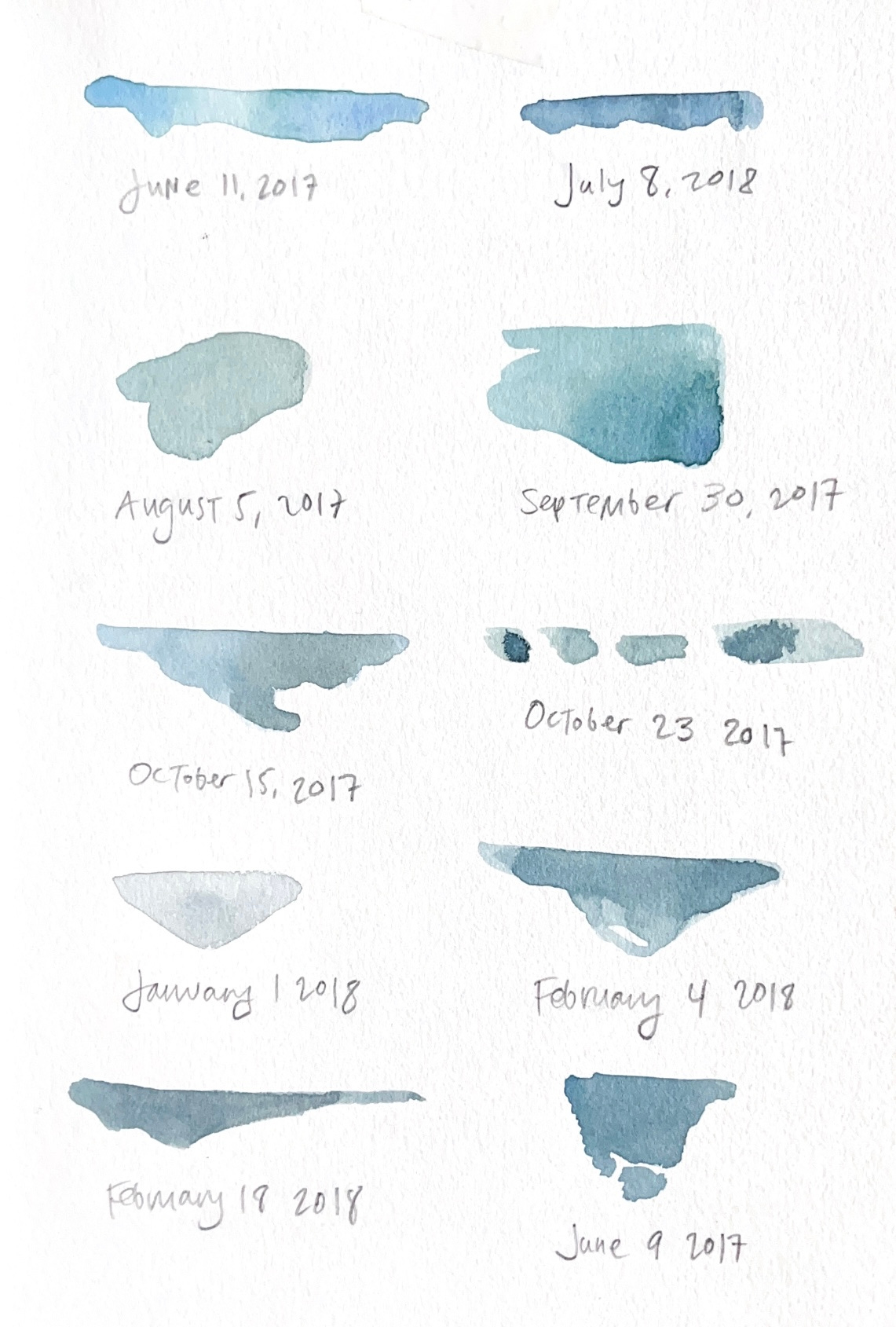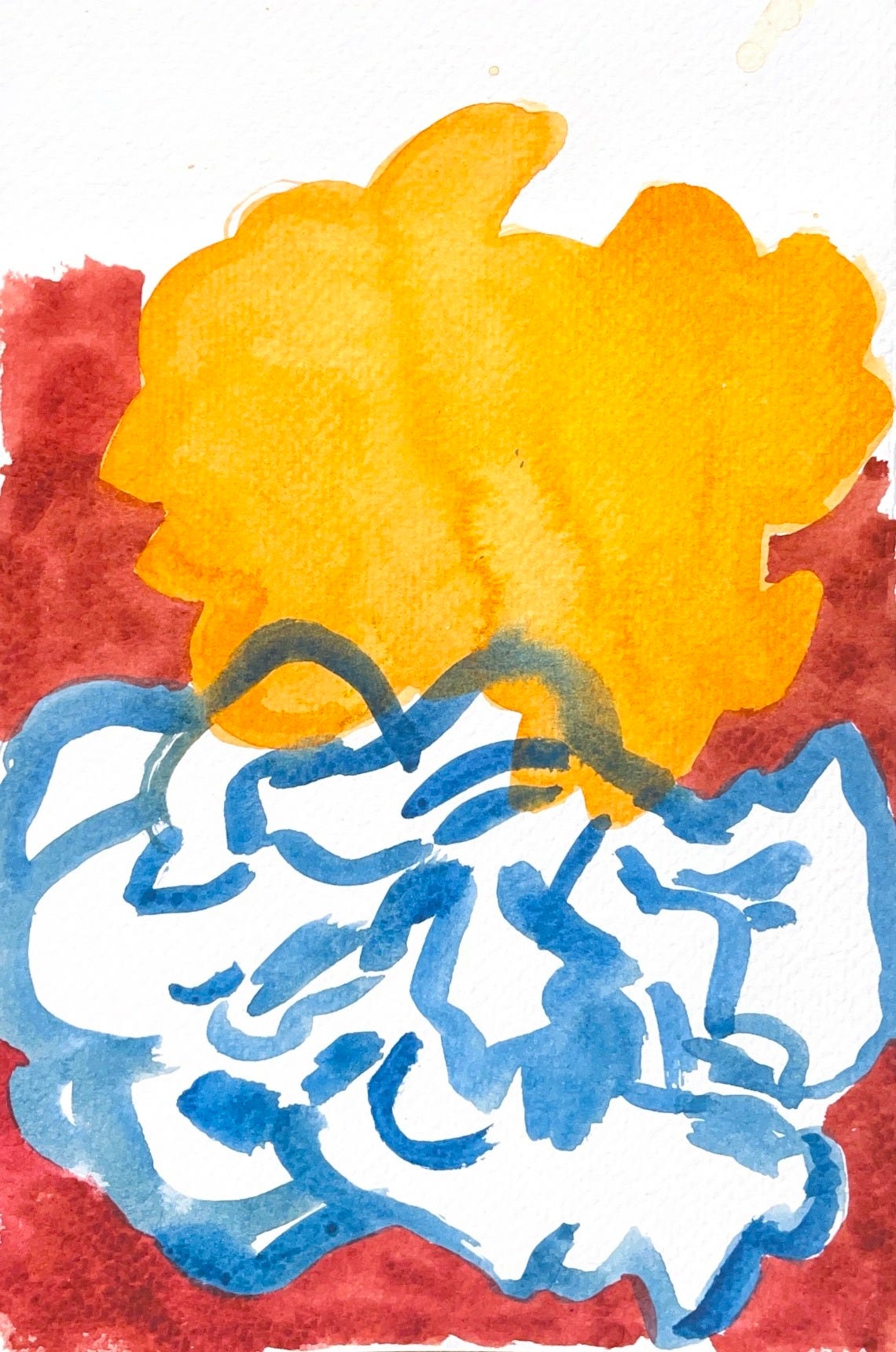Last September, I spent a week making paintings of doors—specifically the door between our kitchen and my downstairs studio office in Berkeley, held ajar.
I remember hoping that the act of doing so would change my life, which I realize does not really make sense. I did enjoy painting those doors, though. I was having a low week, a low month. It was nice to spend time with my reality simply by painting a little bit of it, rather than questioning its value. For me the door was not just a door but a feeling: a white, glowing rectangle that greeted me whenever I swiveled from my desk and turned to head up the stairs, a shape I always associated with leaving my mind and walking back up into the rest of my life.
In June, shortly after we moved to New York, I went to Amy Sillman’s show “To Be Other-Wise” at Gladstone Gallery. Sillman is probably most well-known for her paintings and drawings that flirt on the border of the abstract and figurative. I discovered her work last fall after I was magnetically drawn to her little orange book Faux Pas. (perfect title, period and all) at Moe’s Books in Berkeley, and bought it on a whim.
It’s a compendium of her essays, lectures, interviews, and also drawings, like this:
One of my favorite pieces was Sillman’s essay “Shit Happens: Notes on Awkwardness,” in which Sillman writes about how central awkwardness is to her art-making process, as well as to her idea of abstraction. “I would say that form is the shape of my discontent, and that what interests me is how form can match that feeling or condition—of funny, homely, lonely, ill-fitting, strange, clumsy things that feel right. In other words, a form that tries to find itself outside of what is already okay. Awkwardness is what I would give this quality, this thing that is both familiar and unfamiliar.”
She also announces, “I couldn’t give a shit about beauty. . . . I just knew that attractiveness was the enemy.”
It’s interesting dipping back into Faux Pas. now after seeing Sillman’s recent paintings in person, to remember her stance against beauty and her championing of awkwardness when all the paintings I saw were quite beautiful. That’s not all they are, of course, and “beautiful” would not be the first descriptor I’d give (mostly because calling a painting beautiful doesn’t say anything about it at all) but the colors are harmonious. The shapes are pleasing to stare at, dynamic on the canvas. None of the paintings looked awkward to me—can a painting look awkward?—even if they don’t portray recognizable imagery.
Sometimes I try (and fail) to explain to myself why I love paintings, particularly abstract paintings. Maybe because it feels like I’m interacting with a memory, or a smell; a part of consciousness that is tangible even if it doesn’t belong to vocabulary or an established visual language. There was one Sillman painting in particular that I loved, and which I looked at for a long time, practically bathing in it, because it called to mind standing under a pine tree in Tahoe. Of course, having recently moved from California, my mind is eager to see California inside everything. But I’m interested in that—I’m interested in an image as it flickers between figurative and abstraction. I’m interested in staring at an image that never quite coheres and instead transmits something deeply mysterious, an inexhaustible image whose meaning or lack of meaning constantly refreshes. The image begins to move, then. That sensation, of waiting for an abstract image to shift into a familiar one, is similar to the sensation of wanting to find home, to recognize and be recognizable. To recognize myself.
It’s maybe embarrassing to admit that the first month living in New York, every time I ran on the treadmill at the gym, I set the screen to show scenes of the central California coast so that as I jogged in place, the familiar cliffs and shoreline scrolled slowly ahead of me. I tried to hear the waves as they crashed. I tried to conjure the smell of the sea, the bay leaves. I hate running inside, but it was what I had to do as long as it was above eighty degrees and humid. The coast imagery, for which I was homesick, made it a little more bearable. Staring at the false landscape as I pounded the false concrete I thought about how, when I lived in Berkeley, whenever I was on a run or a walk, I liked to fixate on the sliver of ocean or mountains that would so often appear at the end of the street. Those glimpses were soothing talismans.
I try not to think about falling (I’ve taken a few bad falls when running outside). It would break the careful illusion I have that I’m sprinting along the Pacific Ocean. But since moving across the country in June it’s felt like half my brain is missing. I have less control over my body. I trip more often, I spill things, I forget how to open doors, I forget which door I just came from. It’s as if I’m an abstract painting. I feel awkward, scrambled, unsure of where I fit, alternatively ecstatic and humbled, and scared at that feeling. When asked why we moved here, we can list several practical reasons but the overarching one was simply intuitive: to try to change something about our lives and see what happened. We were running toward an abstract sliver of ocean, an idea toward which we pointed ourselves, as if by running we could reach it.
“The real, like the body, is embarrassing,” Sillman writes. “But you’re stuck there. That tension is what abstraction is partly about: the subject no longer entirely in control of the plot, representation peeled away from realness. This ambivalent state is precisely the state of mind for making a painting, being stuck with the uncertain future of the loveable, but fallible, body that is the artwork.”
Sillman’s paintings don’t appear awkward because Sillman’s idea of awkwardness isn’t necessarily related to appearance—the finished product—but how it feels to make something, and specifically how to paint an image when you’re engaging with it based off pure intuition, instead of reproducing it from a source: “this is particular to abstract painting,” she writes, “where you often don’t really ‘know’ what you are doing, and so you are doomed to work in between hoping and groping.” I know that Sillman is against beauty but this is the most beautiful thing in the world to me, this push and pull, as you create something, between despair and gut insight. It’s the aspect of art-making that aligns with how it feels to build a life.
As summer slid into August and the weather stayed hot and humid, I started running to scenes of New England autumn instead: red and yellow leaves; wet, purple dirt. Daydreaming of chillier mornings and shorter days. The one constant, it seems, no matter which coast I live on, is my longing to always be somewhere else, to dangle in front of myself an abstract idea of elsewhere in order to give my life meaning—to give it a feeling of “in progress”-ness. For a long time I wanted to have my life figured out, to be finished, without realizing that’s what I wanted. Once I was able to articulate to myself in language that’s what I yearned for, I wondered why I would ever want such a thing.
To me, process is the most interesting part of art-making. It’s the part that changes the artist—hence, why I thought I could change my life by painting the door over and over. Yet process is the hardest event to convey with a finished piece of art. At first I wrote that “process is mostly invisible when we engage with a work of art,” but I don’t actually think that’s true. Maybe one of the things I like about abstract paintings is that it attempts to bring the viewer into the process of making the image—the viewer is forced to make the image, too. Or, more than that: an abstract painting is about process, about paint and shape and color and marks, in the way a portrait or landscape painting isn’t.
I don’t really make abstract paintings myself—sometimes it seems these days I hardly ever paint at all—but one afternoon last year I decided to paint a dried rose which I kept for years in a small vase on my desk. It was a rose I’d clipped from our front yard during the long terrible summer of 2020. As I painted it again and again the rose grew more and more abstract. I painted ten versions of the rose in the morning and then again at lunch, obsessed. I needed to paint them the way I needed to eat. I wanted to expand the possibility of what the rose might look like—to make the rose more adaptable as an image and myself more adaptable in the process. It was not so much seeing the rose that compelled me but seeing myself see the rose—and the idea that, if I kept going, somewhere off in the future, a truly strange and startling image would emerge on the paper. The idea that I could surprise myself, that I might not know where I was going.
Reading/have read lately: The Long Form by Kate Briggs. If Only by Vigdis Hjorth. Intermezzo by Sally Rooney. Confessions by St. Augustine (slowly). Swann’s Way by Marcel Proust (even more slowly). With My Back to the World by Victoria Chang.
The New Age Bible by Sheila Heti in Harper’s: “I was amazed by the intense effect the book was having on me. The grandness of its vision was brightening my midlife certainty that my days would only grow dimmer and narrower. Its beguiling logic made me feel elated, lightheaded. After even a few minutes of reading, the world would start to feel dislodged from reality and new.”
The Own-Work Woodshed by Kate Wagner in her Substack, The Late Review: “The prevailing capitalist idea that all writing has to have a ready-made audience, that it must be immediately polished, good, complete, innovative, and salable is antithetical to practice and therefore antithetical to writing.”
The Return of Ta-Nehisi Coates by Ryu Spaeth in New York Magazine: “He was astonished by the plain truth of what he saw: the walls, checkpoints, and guns that everywhere hemmed in the lives of Palestinians; the clear tiers of citizenship between the first-class Jews and the second-class Palestinians; and the undisguised contempt with which the Israeli state treated the subjugated other. For Coates, the parallels with the Jim Crow South were obvious and immediate.”
The Trouble With Friends by Weike Wang in The New Yorker: “I suppose hearing the constant chatter about friends has made me consider my own, and how hard it can be to maintain these bonds as an adult. Mostly, what I notice is attrition: I lose more friends than I make.”








